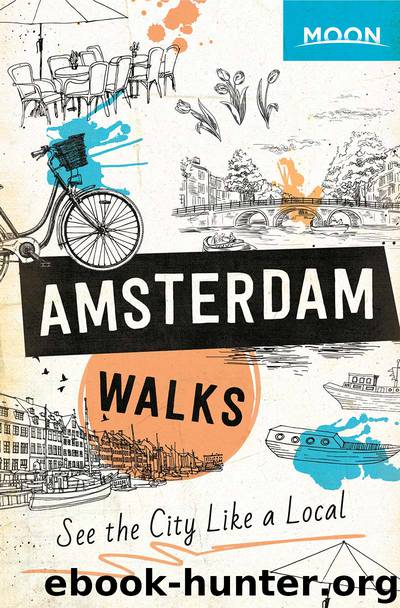Moon Amsterdam Walks by Moon Travel Guides

Author:Moon Travel Guides
Language: eng
Format: epub
Publisher: Avalon Publishing
Published: 2019-03-14T16:00:00+00:00
SIGHTS & ATTRACTIONS
12 Designed by the famous Dutch architect H. P. Berlage, Mercatorplein was destined to become the focal point of Amsterdam West in the mid-1920s. But its cafés, theater, cinema, and department store never materialized, and the square took on a purely residential and business function. It wasn’t cheap to live here, so at first it attracted mainly affluent newcomers. By the 1980s, however, the area had fallen into disrepair and had earned a bad reputation. It has since gone through two renovations—in 1998 and again in 2008—that have breathed new life into the square and its surroundings.
Mercatorplein, Tram 7, 13 Mercatorplein
13 Amsterdam West is a magnet for lovers of the Amsterdam School, an architectural style that developed in the Netherlands between 1910 and 1930. The Jeruzalemkerk (Jerusalem Church) is without doubt one of the finest buildings constructed in that style (1928-1929). The architect deliberately designed the church so it would be attached to housing, to express God’s desire to live among the people. The symmetry of the façade and the fact that the church is oriented north-south, rather than the usual east-west, is striking. The seven stained-glass windows symbolize the seven days of creation.
Jan Maijenstraat 14, www.jeruzalem-kerk.nl, Tram 7, 13 Mercatorplein
14 The Vespuccistraat is a good example of how the neighborhood has taken matters into its own hands. Nearly one hundred years ago, the street was designed as a green avenue leading to the Erasmus Park, with front gardens, rare trees, and houses in Amsterdam School style. Over recent years, half of the gardens were lovingly maintained by the residents, with the other half left in the uninspired hands of the municipality. Then, residents decided the gardens should be restored to their 1920s appeal. Fortunately, 40 Japanese ginkgo trees have stood the test of time—they are some of the few that can be found in the Netherlands.
Vespuccistraat, Tram 13, 18 Marco Polostraat
19 Bosleeuw Midden now seems to be a typical residential area, but in 1935 it was a revolutionary idea in the context of the “Bosch en Lommer expansion plan.” Architect Cornelis van Eesteren worked with open housing blocks, open courtyards, and lush greenery. It was an example of “new construction” in which home, work, and recreation were separated and accommodation was affordable. Behind, on the Leeuwendalersweg, you’ll find the piggelmeewoningen (“gnome homes”—Piggelmee is a gnome in an Old Dutch book for children). They’re probably the most intimate single-story family homes in the city at 366 square feet (34 square meters)—though not for long, as they’re due to be demolished.
Tussen de a10, Admiraal de Ruijterweg, Wiltzanghlaan En Leeuwendalersweg, Tram 7 Bos en Lommerplein
24 Molen de Bloem (Flower Mill) might look as though it’s been here for centuries, but that’s not the case. From 1786 to 1878 it stood in the center of Amsterdam, on the Bloemgracht (Flower Canal), from where it got its name. When the Marnixstraat was laid in the 1870s, the mill had to move. It was rebuilt in 1921 and has since been modernized several times.
Download
This site does not store any files on its server. We only index and link to content provided by other sites. Please contact the content providers to delete copyright contents if any and email us, we'll remove relevant links or contents immediately.
Annapurna by Maurice Herzog(2878)
Liar's Poker by Michael Lewis(2848)
A Forest Journey by John Perlin(2616)
Atlas Obscura by Joshua Foer(2375)
Cuba by Lonely Planet(2214)
The Ogre by Doug Scott(2147)
Photographic Guide to the Birds of Indonesia by Strange Morten;(2114)
Tokyo by Rob Goss(2039)
All Things Reconsidered by Bill Thompson III(1979)
A TIME OF GIFTS by Patrick Leigh Fermor(1869)
DK Eyewitness Top 10 Travel Guides Orlando by DK(1835)
Abbey in America by Murray John A(1824)
The Splendid and the Vile by Erik Larson(1817)
Fatal Storm by Rob Mundle(1808)
Trail Magic by Trevelyan Quest Edwards & Hazel Edwards(1783)
INTO THE WILD by Jon Krakauer(1756)
Top 10 Dubai and Abu Dhabi by DK Travel(1740)
Touching the Void by Joe Simpson(1738)
Lonely Planet Australia by Lonely Planet(1707)
